速看!刚考完CPA接着考ACCA为什么说是一种明智的选择
发布时间:2020-04-17
ACCA和CPA都是财会行业顶尖级的证书,一个是国内财会行业“大佬”,拥有签字权;另一个是拥有国际视野的对自己有全方位提升的国际特许公认会计师。有很多考完CPA的小伙伴选择了ACCA考试,用来提升自己的国际视野,那么对于刚考完CPA的小伙伴来说,接着考ACCA是一种明智的选择,来听51题库考试学习网说说理由。
1、互相融合
CPA的考试课程主要分为专业阶段的会计、审计、财务成本管理、经济法、税法、公司战略与风险管理六门课程;综合阶段的两个职业能力测试(试卷一、二),共8门。
ACCA考试科目15门,分为两个阶段(基础阶段、专业阶段)、四个类别(知识课程、技能课程、核心课程、选修课程),涵盖了财务会计和管理会计方面的核心知识、必备技能以及更为专业、能够解决更高级更复杂问题的知识技能。
ACCA专业阶段考试大纲及考试形式与注会综合阶段相似,国际会计准则与我国会计准则趋同,考取ACCA证书注会学员占绝对优势。
二者有着许多相似科目,但ACCA的课程更为全面和详尽。所以考完CPA的小伙伴完全可以立马着手进行ACCA的复习,CPA的学习使得你的财会基础更扎实。因为ACCA非常重视培养学员的逻辑分析能力和实际工作能力。课程系统、合理,内容紧凑、相关,难度阶梯式递进,在潜移默化中使学员的专业能力得到质的转换和提高。
2、免考九门
ACCA协会针对中国注册会计师协会有9门的免考政策(ACCA考试目前共13门考试),如果您已通过注册会计师考试,这代表着您与国际会计师之间只有一步之遥。
注会综合阶段通过的学员,凭全科合格证可豁免ACCA 9门科目。
仅需通过专业阶段4门考试即可获得ACCA会员资格。
3、国际高认可度
ACCA是特许公认会计师,在我国也俗称为国际注册会计师,知名度仅次于CPA,以全英文考试、科目众多、难度较大、含金量高等的特点,在财会领域的地位不可撼动,目前在中国已拥有超过2万多名会员和4万多名学员,尤其深受大学生考证党的青睐。
ACCA之所以认可度较高,除了其国际出身和体系设计外,其先入为主式的先机抢占和市场布局、强大的公关和宣传攻势、广泛的学员群体和关系网络等,都使其具有一定优势。四大会计师事务所、世界500强企业等都是ACCA的认可雇主企业,无形中也提高了ACCA的国际认可度。
不同的经济领域、不同的雇主性质,ACCA会员都发挥着自己的所学之才。通过ACCA特许公认会计师的学习,学生不仅取得国际会计师资格证书,还可以涉足审计、税务、会计、管理等多个领域进一步实践和深造,有效地提高了学生的就业竞争力、就业范围和社会适应力。
以上就是今天51题库考试学习网为大家分享的全部内容,大家是否清楚了呢?希望本篇文章能够帮助到大家,如有其他疑问请继续关注51题库考试学习网!
下面小编为大家准备了 ACCA考试 的相关考题,供大家学习参考。
(b) Prepare a consolidated statement of financial position of the Ribby Group at 31 May 2008 in accordance
with International Financial Reporting Standards. (35 marks)

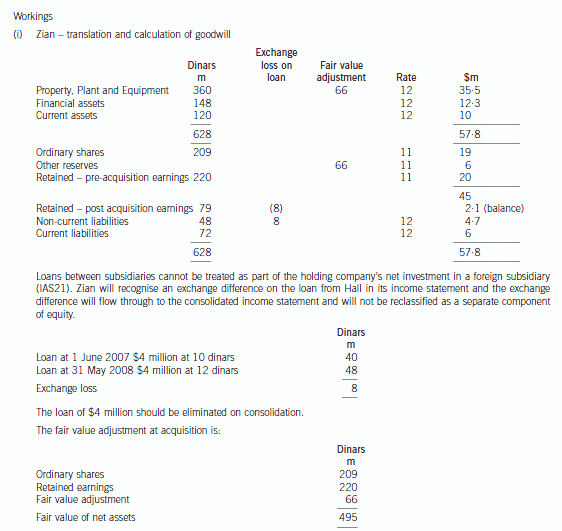



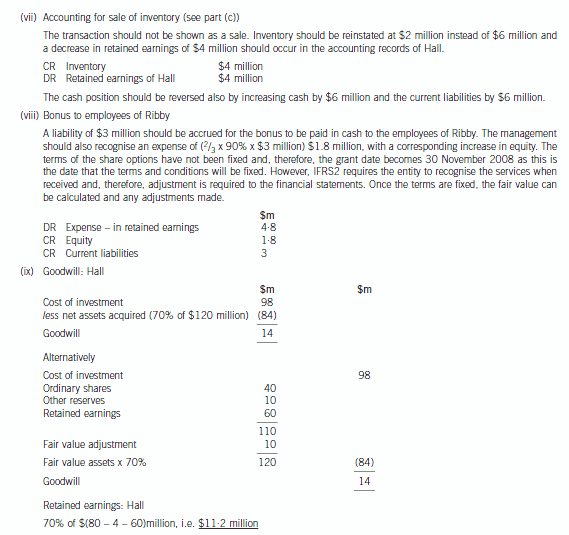
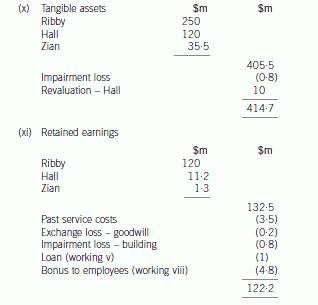
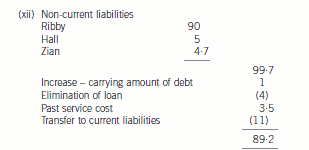
(c) Risk committee members can be either executive or non-executive.
Required:
(i) Distinguish between executive and non-executive directors. (2 marks)
(c) Risk committee members can be either executive on non-executive.
(i) Distinguish between executive and non-executive directors
Executive directors are full time members of staff, have management positions in the organisation, are part of the
executive structure and typically have industry or activity-relevant knowledge or expertise, which is the basis of their
value to the organisation.
Non-executive directors are engaged part time by the organisation, bring relevant independent, external input and
scrutiny to the board, and typically occupy positions in the committee structure.
(d) Wader has decided to close one of its overseas branches. A board meeting was held on 30 April 2007 when a
detailed formal plan was presented to the board. The plan was formalised and accepted at that meeting. Letters
were sent out to customers, suppliers and workers on 15 May 2007 and meetings were held prior to the year
end to determine the issues involved in the closure. The plan is to be implemented in June 2007. The company
wish to provide $8 million for the restructuring but are unsure as to whether this is permissible. Additionally there
was an issue raised at one of the meetings. The operations of the branch are to be moved to another country
from June 2007 but the operating lease on the present buildings of the branch is non-cancellable and runs for
another two years, until 31 May 2009. The annual rent of the buildings is $150,000 payable in arrears on
31 May and the lessor has offered to take a single payment of $270,000 on 31 May 2008 to settle the
outstanding amount owing and terminate the lease on that date. Wader has additionally obtained permission to
sublet the building at a rental of $100,000 per year, payable in advance on 1 June. The company needs advice
on how to treat the above under IAS37 ‘Provisions, Contingent Liabilities and Contingent Assets’. (7 marks)
Required:
Discuss the accounting treatments of the above items in the financial statements for the year ended 31 May
2007.
Note: a discount rate of 5% should be used where necessary. Candidates should show suitable calculations where
necessary.
(d) A provision under IAS37 ‘Provisions, Contingent Liabilities and Contingent assets’ can only be made in relation to the entity’s
restructuring plans where there is both a detailed formal plan in place and the plans have been announced to those affected.
The plan should identify areas of the business affected, the impact on employees and the likely cost of the restructuring and
the timescale for implementation. There should be a short timescale between communicating the plan and starting to
implement it. A provision should not be recognised until a plan is formalised.
A decision to restructure before the balance sheet date is not sufficient in itself for a provision to be recognised. A formal plan
should be announced prior to the balance sheet date. A constructive obligation should have arisen. It arises where there has
been a detailed formal plan and this has raised a valid expectation in the minds of those affected. The provision should only
include direct expenditure arising from the restructuring. Such amounts do not include costs associated with ongoing business
operations. Costs of retraining staff or relocating continuing staff or marketing or investment in new systems and distribution
networks, are excluded. It seems as though in this case a constructive obligation has arisen as there have been detailed formal
plans approved and communicated thus raising valid expectations. The provision can be allowed subject to the exclusion of
the costs outlined above.
Although executory contracts are outside IAS37, it is permissible to recognise a provision that is onerous. Onerous contracts
can result from restructuring plans or on a stand alone basis. A provision should be made for the best estimate of the excess
unavoidable costs under the onerous contract. This estimate should assess any likely level of future income from new sources.
Thus in this case, the rental income from sub-letting the building should be taken into account. The provision should be
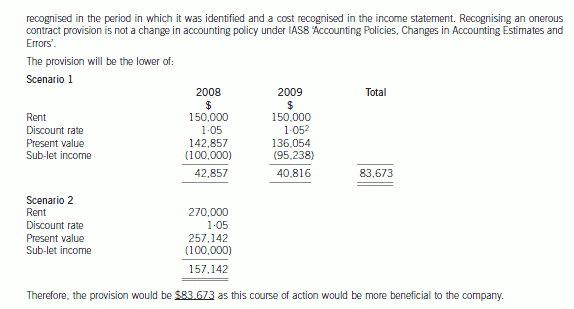
声明:本文内容由互联网用户自发贡献自行上传,本网站不拥有所有权,未作人工编辑处理,也不承担相关法律责任。如果您发现有涉嫌版权的内容,欢迎发送邮件至:contact@51tk.com 进行举报,并提供相关证据,工作人员会在5个工作日内联系你,一经查实,本站将立刻删除涉嫌侵权内容。
- 2020-01-10
- 2020-01-10
- 2021-06-25
- 2020-01-09
- 2020-02-22
- 2020-08-16
- 2020-04-23
- 2020-05-20
- 2020-04-21
- 2021-05-08
- 2020-05-02
- 2020-04-07
- 2020-03-03
- 2020-01-10
- 2021-06-24
- 2020-04-21
- 2020-01-10
- 2020-04-20
- 2020-01-10
- 2021-05-08
- 2020-01-10
- 2020-03-27
- 2020-01-10
- 2020-01-09
- 2020-01-10
- 2020-04-30
- 2020-04-14
- 2021-10-15
- 2020-04-20
- 2020-01-10